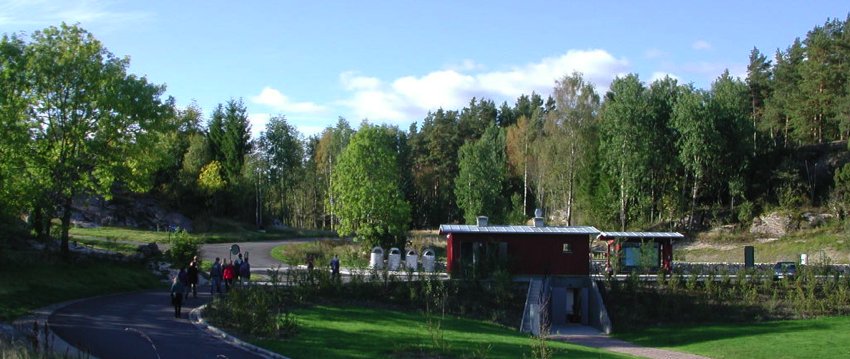
Toilet Facilities at the Tegen Rest Area. Source: JENSSEN (2012)
Tegen rest area in Tanum municipality, Sweden was visited during an excursion held by this STEP University course. This information is a short presentation of Tegen. The students that visited Tegen made a small documentation of the system as part of their assignments.
Tegen is located along E6, the main highway from Norway and is south to Gothenburg and Copenhagen. Tegen is an excellent example of how a roadside stop with toilet facilities can be designed. Tegen has dry toilets and all the excreta is collected in chambers below the toilet room. The chambers are 2x2x2m and the first chamber was emptied after 6 years of use. Excess liquid has to be removed more frequently. Both the solids and the liquids are handled by a nearby farmer and used as fertiliser and soil amendment (see also reuse of urine and faeces in agriculture). The rest area offers excellent landscaping and play facilities for children in addition to tables and a source separating solid waste collection system. Tegen was built in 2002 and has been elected the best roadside stop in Sweden for several years.
Tegens rastplats bäst i Sverige
Newspaper article on the Tegen roadside rest area in Sweden, which is an excellent example of how a roadside stop with toilet facilities can be designed. This article is in Swedish.
EKLUND, A-K. (2012): Tegens rastplats bäst i Sverige. Sweden: Bohusläningen URL [Accessed: 21.11.2012]Language: Swedish
Reduction Efficiency of Index Pathogens in Dry Sanitation Compared with Traditional and Alternative Wastewater Treatment Systems
Bad water, sanitation and personal hygiene combinedglobally considered as the second major threats to human health. Poor water supply, sanitation, and personal hygiene accounted for 2.6 million deaths and 93 million DALYs in 1990. These were considered the top 2 of risk factor groups for the total global burden of disease. It is therefore of importance to define the efficiency of different treatment and exposure barriers to safeguard against disease transmission.
STENSTRØM, T.A. ECOSANRES (2002): Reduction Efficiency of Index Pathogens in Dry Sanitation Compared with Traditional and Alternative Wastewater Treatment Systems. Solna, Sweden: EcoSanRes URL [Accessed: 28.11.2012]


